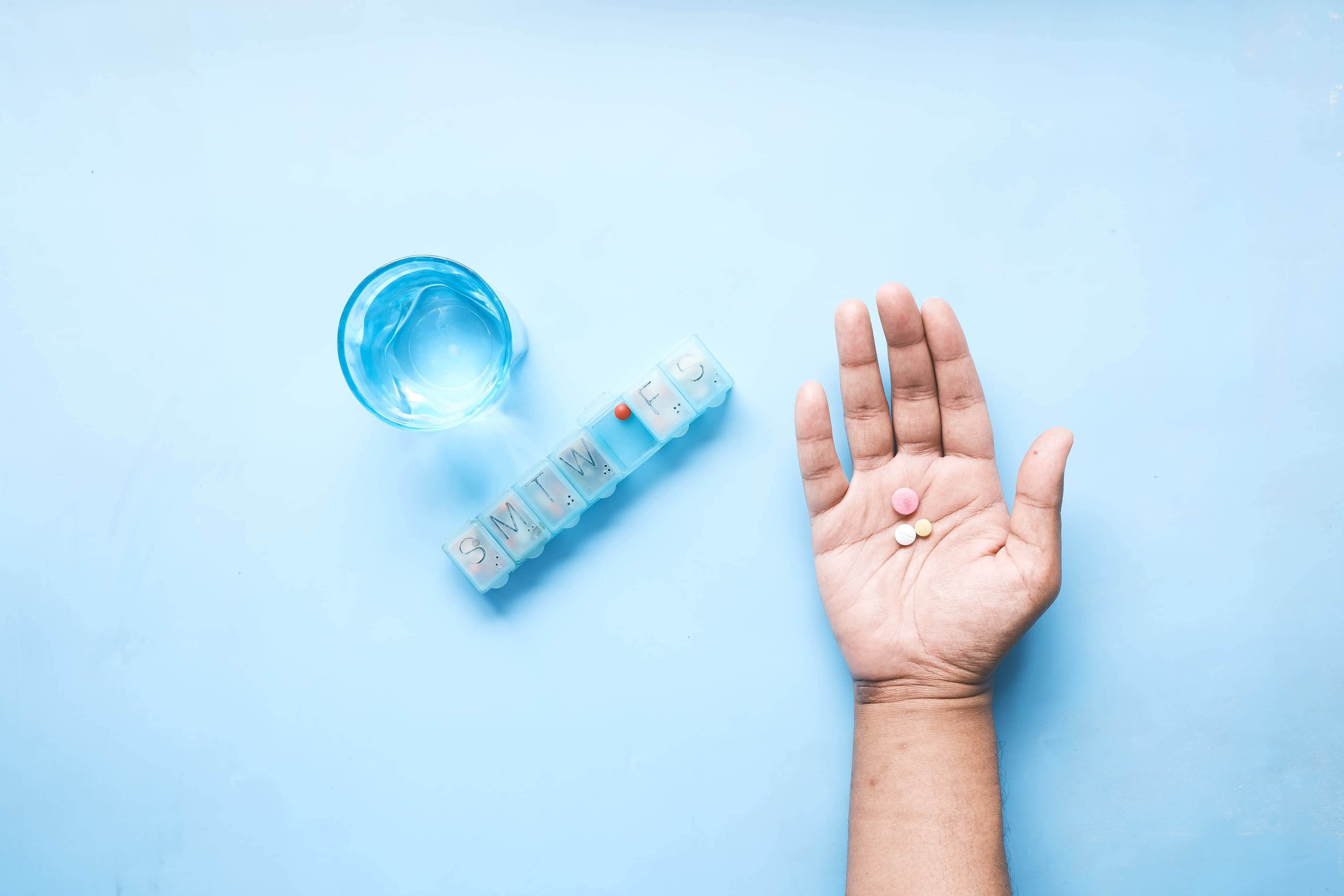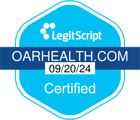Naltrexone vs. Naloxone: What's The Difference?

In This Article
Reviewed by Dr. Joshua Lee, MD, Chief Medical Officer, Board-Certified in Addiction Medicine.
Naltrexone and naloxone sound similar, and both drugs are used in the treatment of substance use issues, but there are significant differences between the two and how they are used.
What Is Naltrexone?
Naltrexone is an opioid antagonist medication prescribed for the long-term treatment of alcohol use disorder (AUD), alcohol cravings, alcohol relapse, and opioid dependence.
You can take naltrexone in pill form or by injection. It works by blocking the euphoric effects associated with drinking alcohol and the pleasurable effects of using opioid substances (1).
How Does Naltrexone Work?
Naltrexone blocks opioid receptors in the brain. This disrupts the chemical feedback loop that rewards you with pleasurable feelings when you drink alcohol or take opioids, thus making it easier to cut down your use and stop completely.
What Is Naloxone?
Naloxone is an opioid antagonist that rapidly reverses the effects of overdose from opioids such as heroin, morphine, oxycodone, and synthetic opioids like fentanyl (2).
If a person is struggling to breathe or has stopped breathing due to an overdose, naloxone can revive their breath. It does not block the effects of alcohol.
Naloxone is given as a nasal spray or via an injection. It is frequently referred to as Narcan, one of its brand names.
How Does Naloxone Work?
Like naltrexone, naloxone binds to opioid receptors in the brain, which blocks the effects of opioid drugs. The medicine brings on symptoms of opioid withdrawal, so emergency medical help is needed as quickly as possible after a person is given naloxone.
Key Differences Between Naltrexone & Naloxone
| Naltrexone | Naloxone (Narcan) |
|---|---|
| Used for longer-term treatment of AUD and opioid dependence | Rapid emergency treatment for life-threatening opioid overdose |
| Single dose works for longer than 24 hours | Single dose displaces opioids from opioid receptors for 30 to 90 minutes |
| Must be opioid-free for a minimum of 7 to 10 days before taking, as naltrexone can cause dangerous opioid withdrawal symptoms | Specifically for use in the case of an opioid overdose |
| Available in daily pill form or as a monthly injection | Available as a quick-acting nasal spray or injection |
| Available only by prescription | Available without a prescription |
Uses Of Naltrexone & Naloxone
Naltrexone is prescribed by a doctor or other qualified healthcare professional for people who are trying to cut their alcohol consumption or quit drinking altogether, or who are trying to stay off of opioids. Oar Health offers an online tool which can assess your level of alcohol use and (with a doctor's guidance) determine if you are an appropriate candidate for naltrexone.
Naltrexone is available as a daily pill or as a monthly injection and is considered a maintenance medication. In most cases, naltrexone is used alongside other treatments, such as counseling, therapy, and support groups.
Naloxone is an emergency medicine that can reverse opioid overdoses. It is not used in the treatment of alcohol use disorder (AUD) and doesn’t assist people trying to cut down on drinking or quit using alcohol. Using naloxone for alcohol cravings will have no effect on the urge to drink. Naloxone is available over the counter at most U.S. pharmacies.
Impact Duration
One dose of a 50-milligram (mg) naltrexone pill is typically effective at curbing alcohol cravings and blocking the effects from drinking alcohol for at least 24 hours. The injectable version of naltrexone is effective for a month (3).
Both naloxone nasal spray and injectable naloxone are effective at blocking the effects of opioids for about 30 to 90 minutes. More than one dose may be needed to successfully stop an opioid overdose (4).
Side Effects
Naltrexone is well tolerated by most people. Side effects are uncommon but can happen. The most common potential side effects include:
- Nausea
- Stomach discomfort
- Dizziness
- Headache
By design, naloxone induces opioid withdrawal symptoms in a person who has overdosed. These symptoms may include:
- Anxiety
- Restlessness
- Irritability
- Muscle aches
- Chills
- Weakness
- Stomach pain
- Diarrhea
- Nausea
- Vomiting
Beyond these withdrawal symptoms, the most common complaints from taking naloxone are nasal irritation from the spray, headache, and joint or muscle pain.
FAQ: Naltrexone vs. Naloxone
Is there a danger of mixing naloxone with alcohol?
Alcohol doesn’t interfere with the action of naloxone in the body, so it is safe to give naloxone to someone who has been drinking.
Remember, naloxone doesn’t block the effects of alcohol, so you will still feel intoxicated if you drink too much alcohol and take naloxone.
Can naloxone be misused?
Naloxone is safe even if multiple doses are taken. It doesn’t produce a “high” feeling and is nonaddictive. Due to its action in the body, it only affects someone if they have taken opioids. It has no effect on someone who doesn’t have opioids in their system.
How similar are the chemical structures of naltrexone and naloxone?
Despite their different intended uses, the chemical structures of naltrexone and naloxone are very similar. Both are in the class of drugs known as opioid antagonists.
Do naltrexone and naloxone require a prescription?
Naltrexone requires a prescription from a doctor or other healthcare professional.
Naloxone is available without a prescription at many pharmacies.
Is naltrexone the same as naloxone?
No. Naltrexone is used to help people cut down on drinking or to stop drinking alcohol altogether, or to maintain abstinence from opioid drugs.
Naloxone is used as an emergency method to reverse an opioid overdose. It does not treat alcohol overuse or misuse.
Are Narcan and naloxone the same?
Yes. When naloxone was first approved by the Food and Drug Administration (FDA) as a medication to treat opioid overdoses, it was widely known by its brand name Narcan.
Since then, the FDA has approved generic versions of naloxone from different drugmakers, but many people still call any of these versions of naloxone Narcan.
Is there a danger of mixing naloxone and naltrexone?
No. Neither drug has any effect on the other, and they are safe to take together.
Does naloxone stop cravings?
Naloxone doesn’t stop alcohol or opioid cravings. Naloxone revives a person from an opioid overdose by blocking the effects of the opioid in the body. There are a number of ways to reduce alcohol cravings, including the use of naltrexone.
In addition, there are drugs other than naltrexone which can reduce alcohol cravings, such as acamprosate (Campral).
Does Narcan work on alcohol?
No. Narcan and generic naloxone only work on opioid drugs like heroin, oxycodone, and fentanyl. Using Narcan for alcohol doesn’t have any effect.
Does Narcan reverse alcohol overdose?
No. Narcan and generic naloxone do not reverse alcohol overdose.
Are You Drinking Too Much?
Is drinking affecting your job? Is alcohol harming your health or relationships? Does your drinking worry you? Ever tried to drink less but failed?
If any of this sounds familiar, and if AUD runs in your family, Oar Health might be right for you. Oar Health offers medication FDA-approved for the treatment of alcohol problems. A daily pill to drink less or quit.
Reviewed by Dr. Joshua Lee, MD, Chief Medical Officer, Board-Certified in Addiction Medicine.
Dr. Lee is a nationally recognized addiction medicine expert and Professor at NYU Grossman School of Medicine. He leads groundbreaking research on naltrexone and buprenorphine for alcohol and opioid use disorders, with a focus on real-world impact in primary care and justice-involved populations.
About The Author
Ian Landau is a journalist who's written extensively about health and wellness since 2010. He is also the author of The Hypochondriac's Handbook (Skyhorse, 2010).
Related Articles
- How It Works
- Alcohol & Health
- Alcohol Misuse & Alcohol Use Disorder
- Strategies to Drink Less or Quit
- Treatment Options
- Medication-Assisted Treatment
- Recovery Stories
- Member Stories
- Moderation Stories
- Sobriety Stories
- ¹ Oar Health membership plans include access to the Oar Health platform, virtual consultations with a healthcare professional, and medication if prescribed by a healthcare provider. 3 month membership plan costs $297, equating to $99/mo.
- ² Self-reported by members after 6 months of Oar Health membership.
- ³ Verywell Health survey of Oar Health members, published March, 2023.
- ⁴ Prescription medication is available only if prescribed by a licensed clinician.
- ⁵ Compounded medications are prepared based on a prescription from a healthcare provider. They are not reviewed by the FDA for safety or efficacy.






